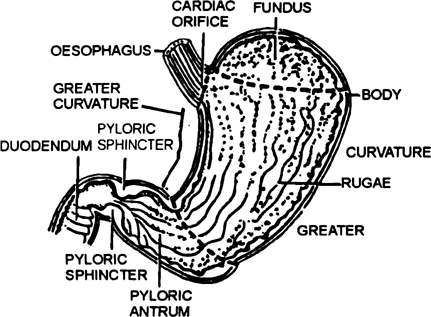The wall of alimentary canal from oesophagus to rectum possesses four layers namely serosa, muscularis, sub-mucosa and mucosa.
i. Serosa is the outermost layer and is made up of a thin mesothelium or the epithelium of visceral organs and has some aconnective tissues.
ii. Muscularis is formed by smooth muscles usually arranged into an inner circular and an outer longitudinal layer. An oblique muscle layer
may be present in some regions.
iii. The submucosal layer is formed of loose connective tissues containing nerves, blood and lymph vessels. It is highly vascular, dense connective tissue. In duodenum, glands are also present in
iv. Mucosa is the innermost lining. This layer forms irregular folds (rugae) in the stomach and small finger-like foldings called villi in the small intestine
Small intestine : Small intestine is distinguishable into three regions, a ‘C’ shaped duodenum, a long coiled middle portion jejunum and a highly coiled ileum.
(1) Duodenum : It has a length of 25 cm. It is C-shaped. The accessory pancreatic duct and haptopancreatic duct opens into duodenum independently. The haptopancreatic duct brings bile and pancreatic juice from gall bladder and pancreas into duodenum respectively. Its opening is guarded by sphincter of oddi. In duodenum, mainly digestion of food occurs. The bile and pancreatic juice act on food in duodenum.
(2) Jejunum : It has a length of bout 6.0 – 7.00 m. Jejunum has length of 4 m and ileum has length of 2.5 m.
(3) Ileum : It is 3 cm wide and is highly coiled. In jejunum-ileum digestion is completed. The inner lining of jejunum-ileum has folds called villi. The cells of villi has microvilli which increase the absorptive surface area.
Wall of digestive tract is not digested because of the following reasons :
1. There is a layer of glycocalyx inner to enteric epithelium which checks the action of enzymes.
2. The protein digesting enzymes are always in inactive stage. They become active on getting mixed with other types of enzymes.
3. There is lining of mucus inner to enteric epithelium which dilutes the action of enzymes on wall of alimentary canal.
It is present in cattle, buffaloes, deer, goats, camels and sheeps. The stomach of ruminant is a compound structure having following four chambers :
1. Rumen - It is the largest chamber which receives oesophagus
2. Reticulum - The rumen leads into reticulum. The reticulum has network of ridges which give it an appearance of honey comb.
3. Omasum - The omasum is a small chamber whose longitudinal folds in omasum bring mechanical breakdown of the food.
4. Abomasum.- The abomasum is the only part which has gastric glands.
Stomach : It is J shaped and present on the left side at anterior end of abdominal cavity posterior to diaphragm.
The stomach has four parts :
(1) Cardiac stomach : It is proximal part. The opening of oesophagus into cardiac stomach is guarded by cardiac sphincter which prevents the regurgitation of food.

Section of the stomach
(2) Fundus : It extends above cardiac aperture and is filled with air. The part of cardiac stomach which extends towards anterior end above level of cardiac aperture is called fundus.
(4) Pyloric stomach : It is the distal narrowest part of stomach which opens into duodenum. Its opening is guarded by pyloric sphincter which permits the passage of fine-food particles into duodenum.
Functions :
1. Food is temporarily stored in stomach for about 4 - 5 hours.
2. The digestion occurs in the stomach and only proteins are digested.
3. Churning of food occurs in the stomach.
